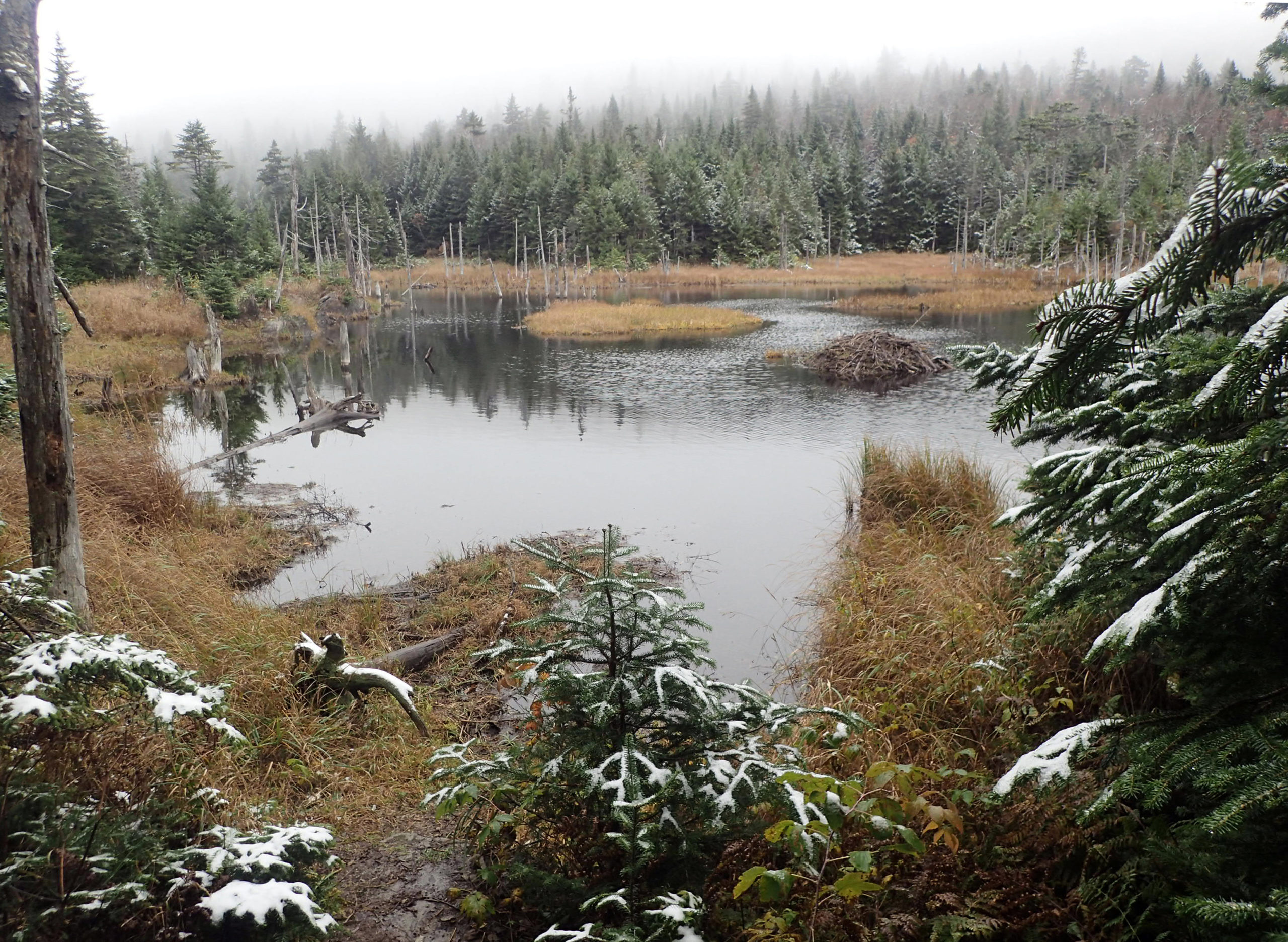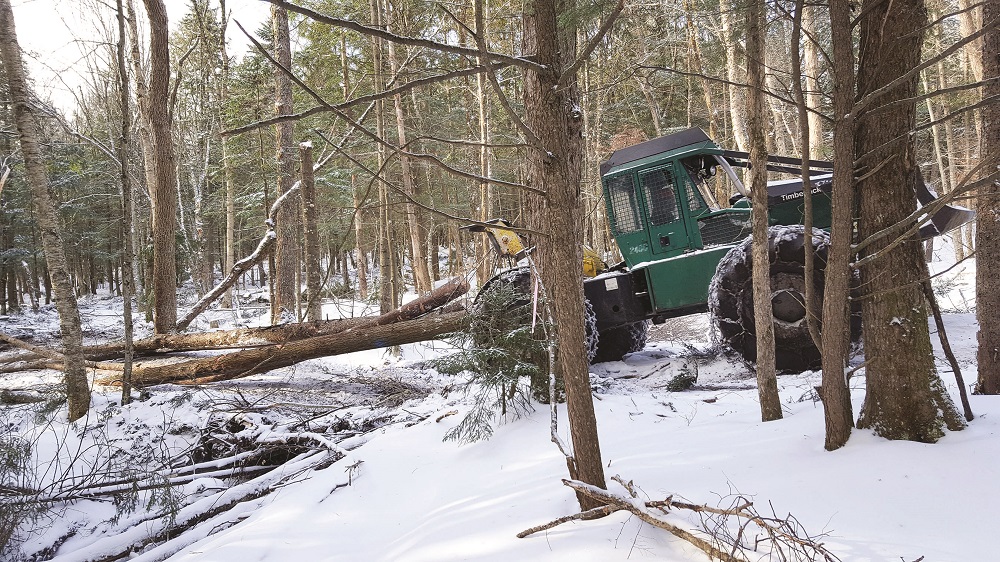This article was written by Mollie Flanigan, GMC conservation manager, and previously appeared in the Summer 2020 Long Trail News.

Vermont’s forested landscape provides the beauty and recreational opportunities that make the state a special place to live, work, and play. The ability of landowners to keep their land forested, however, often hinges on their capacity to financially sustain the land. Timber harvesting can be an important tool in that effort.
The Green Mountain Club owns 3,500 acres of forest on seventeen properties and harvests the land strategically to meet our broader goals for land, trails, and community engagement. This year we are celebrating the conclusion of the largest timber harvest in our 110-year history.
In 2009 the club set out to demonstrate that world-class hiking trails can be managed next to a well-designed and -executed timber harvest. In the same year, the club built the new Visitor Center in Waterbury Center, using local lumber and installing an efficient gasification wood-fired boiler for space heat and hot water.
GMC then needed fifteen to twenty cords of firewood annually, ideally from sustainably designed local harvests. “The club saw a timber harvest on our own property as an opportunity to demonstrate best practices for low impact logging that would be compatible with recreation,” recalled Pete Antos-Ketcham, director of stewardship and manager of facilities for the club in 2009. “We partnered with Vermont Family Forests, and used their harvest guidelines as a template for our work. A forester helped GMC develop a long-range harvesting schedule that would enable the club to meet the requirements for the State of Vermont Current Use Program, supply our firewood, and generate a modest income to support GMC’s work.”
The club selected its 1,870-acre Meltzer tract in Lowell for harvest. Many hikers enjoy the Frank Post Trail and the Forester’s Trail that loop through the tract, 2.75 miles of Long Trail located along its western edge, and Tillotson Camp. It was a perfect property to show how forestry and hiking trails can be compatible uses.
To design the harvest, GMC’s forester carefully considered the property’s unique and fragile natural resources, especially the many seeps in the high elevation northern hardwood forest that feed the forest and the headwaters of Lockwood Brook, a significant tributary to the Missisquoi River. The land ranges from 1,145 feet to 3,360 feet above sea level. Montane forests cover its higher portions providing habitat for the Bicknell’s thrush (Catharus bicknelli), a rare and imperiled bird in Vermont.
GMC evaluated these and other natural resources, and the ecosystem services the property provides. Analysis required more than 100 plots and multiple reconnaissance transects across the tract, as well as data on herbaceous species, shrubs, ground cover, aquatic features, geology, wildlife and avian habitat, snags, cavity trees, and dead and down material. These data informed the design of the harvest and how it would be accomplished.
A key decision was to conduct the harvest in winter on frozen ground, when streams can be forded with iced-in temporary bridges. Winter harvesting both protects fragile wet soils from erosion and avoids the busiest hiking seasons.
The club’s Long Trail System Management Plan recommends timber harvests leave an undisturbed 1,000-foot corridor for the Long Trail, and 500-foot corridors for side trails. So the logging in Lowell removed no trees within 250 feet of the Frank Post or Forester’s trails. Logging road and skid trail crossings of hiking trails were minimized, and were perpendicular to the trails whenever possible.
GMC decided to not harvest above 2,400 feet to protect the slow growing and sensitive forest there, and to avoid seeking a time consuming and expensive Act 250 permit.
Another key decision was to employ skilled loggers with chainsaws, rather than heavy mechanized equipment. Human sawyers remove each tree individually, and can minimize adverse impacts much better than whole-tree harvesting machines, especially on steep slopes and thin soils. The club hired two local loggers, which also ensured that the work supported the local economy and forest industry.
Harris Roen, a licensed forester and owner of Long Meadows Resource Management LLC, designed and managed the operation. He assessed and marked each tree, and planned access to harvest areas well in advance. Roen designed the harvest as a selective thinning, choosing trees for removal based on health, vigor, spacing, wildlife, sale value, ease of access, and remaining growing stock, among other criteria.
In addition, several patch cuts of up to one acre in size were cut to create early successional habitat. Patches of dense, young, vigorously growing trees are uncommon on the maturing forests of the northern Green Mountains, and they add structural diversity. This enhances bird habitat by creating favorable conditions for interior forest species such as the chestnut-sided warbler and white-throated sparrow. Audubon Vermont recommended such patch cuts in a forest bird habitat assessment as the harvest plan was developed.

The Meltzer tract has a long history of timber harvests. In the 1960s and 1970s the land was aggressively cut, and today one can still trace its extensive network of old logging roads. After GMC took ownership in 1987, the club enrolled it in Vermont’s Current Use Program, and then used the required professionally designed management plan to guide activities there.
The old logging roads were of particular concern since many of them had been poorly laid out, used during the wrong time of year, and not maintained to control erosion. GMC worked with the U.S. Natural Resources Conservation Service and the State of Vermont to install drainage ditches and harden surfaces with crushed stone on the worst sections. That improved access for our timber harvest, and will protect the site and water quality for years to come.
GMC’s harvest took place each winter from 2009 to 2019, yielding more than 800,000 board feet of timber and 2,200 cords of firewood at a value of almost $213,000 for the club’s land conservation program and general operating funds. (A board foot is a square foot of wood an inch thick; a cord is a stack of firewood of 128 cubic feet.) GMC also retained about 100 cords of firewood for heating our headquarters.
Now that the harvest is finished few hikers will notice signs of it which demonstrates how forest management and recreation can coexist. As years pass it will take a trained eye to see any evidence of it.
GMC’s next ten-year management plan calls for the forest to grow in peace, with a potential selective thinning in 2030.
“It’s been very meaningful work for me,” said Roen. “This job is living proof that backcountry recreation and forest management can be successful on the same site. As a landowner, GMC has been a responsible steward by improving overall quality of the remaining trees, creating enhancements for wildlife, supporting the local working lands economy, and generating meaningful income to help fund stewardship programs. It’s nice to see the club’s commitment to responsibly managing their holdings into the future.”
“It was a pleasure to work up there,” said Ronnie Stearns, a sawyer who worked on the Meltzer harvest for six years. “The steep terrain and skid distances made it a challenge, but it’s a beautiful mountain. There will be another nice cut of timber up there some day, no doubt.”



















Leave a Reply